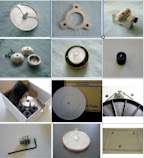Sharing with you here Ralf's braced acrylic plinth (with red top) and adjustable aluminium feet upgrades:
Thanks, Ralf !
Let's see Ralf's first reaction when hearing his transformed deck play.....
Hi Michael, Just let you know that the installation of the plinth last sunday was successful. I was floored when we first heard it play! The improvement was leaps and bounds compared to the last time i heard it. It has more punch, sound is tighter, it has more bass but its not overpowering and somehow balances the brightness of the highs of my Focal speakers! It was well worth all the expenses for the upgrade. I cant wait to do the last upgrade of the pulley, belt and platter., and hope that it will still make it sound better! Here's a couple of snapshot i made of the TT. Thank you so much for your help! Best regards, Ralf |
















